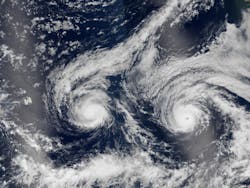Florence Knocks Out Power to 1/2 Million within First Few Hours. Up to 3 Million Outages Expected
On Friday morning, just a few hours into what is expected to be a multi-day storm, Hurricane Florence had knocked out power to half million households and businesses in the Carolinas — and the numbers kept climbing, according to Poweroutages.us.
In a news conference Wednesday before the hurricane struck, Duke Energy executives said power may be out for weeks, as the powerful storm dumps historic rain and floods the southeast states.
“This is no ordinary storm and people could be without power for a very long time, not days, but weeks” — David Fountain, Duke
“This is no ordinary storm and people could be without power for a very long time, not days, but weeks,” said David Fountain, president of Duke Energy North Carolina.
About 20,000 workers were prepared to help with restoration at that time, with 9,400 sent from other utilities as far away as Texas. Even with the additional workers, the utility expects restoration to be difficult given the likelihood of extensive power line collapse and widespread flooding of utility equipment.
Based on historic modeling, the utility expects 1 to 3 million customers to lose power, with the worse case scenario occuring with a Wilmington landfall and a turn by the storm into North Carolina.
Note: The Department of Energy is also providing periodic information about outages and other hurricane related data here
Southeast slow on microgrids
The Southeast has been relatively slow to install microgrids – so far. Similar storms elsewhere have acted as a catalyst for their development.
Connecticut launched a community microgrid grant program following Hurricane Irene and a freak snow storm in October 2011 that caused prolonged power outages as trees, heavy with foliage and snow, brought down utility wires.
Following Superstorm Sandy in 2012, other Northeast states began offering grant programs for development of microgrids for communities, hospitals, water treatment facilities and other critical infrastructure. Most notable among them is the NY Prize, administered by the New York State Energy and Research Development Authority.
Last year’s Hurricane Maria — blamed for 3,000 deaths in Puerto Rico after parts of the island lost power for months — led to significant microgrid development on the island. The US Army Corp and private companies installed simple microgrids for quick power restoration. Meanwhile, Puerto Rico’s government created rules to encourage more sophisticated microgrid projects and issued a solicitation for five microgrids at industrial sites.
In California, microgrids are being developed to ensure power when earthquakes or wildfires damage the central grid.
Microgrids help keep power flowing during a disaster by islanding — or disconnecting — from the disabled grid and activating on-site generators that supply electricity to customers nearby.
Learn more about how microgrids prevent power outages. Subscribe to the free Microgrid Knowledge newsletter.
*This story was originally published Sept. 12, 2018 and updated Sept. 14, 2018.
About the Author
Elisa Wood
Editor-in-Chief
Elisa Wood is the editor and founder of EnergyChangemakers.com. She is co-founder and former editor of Microgrid Knowledge.
